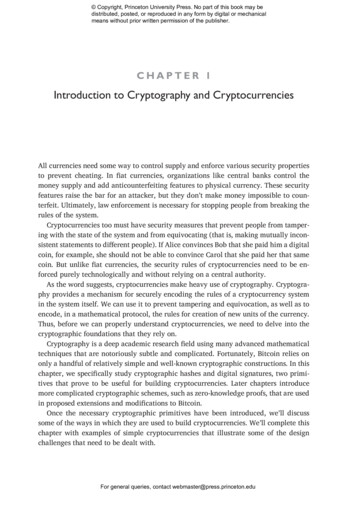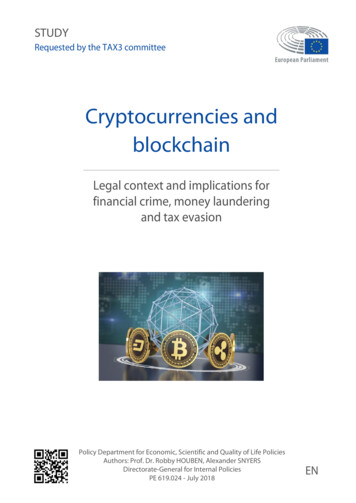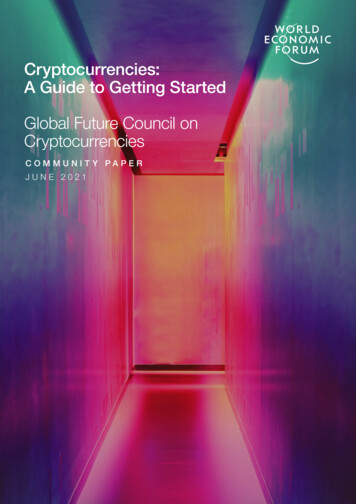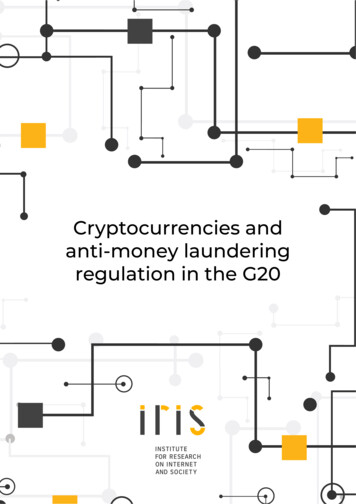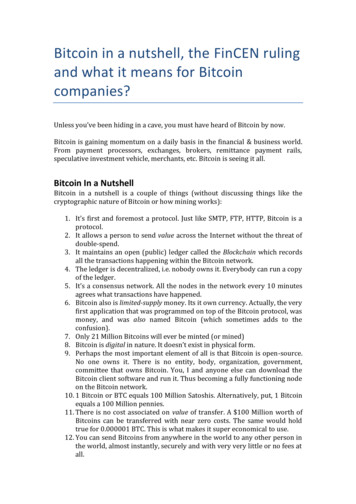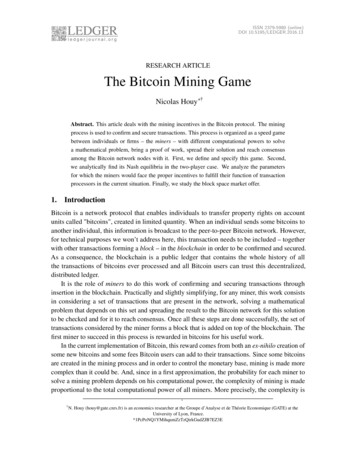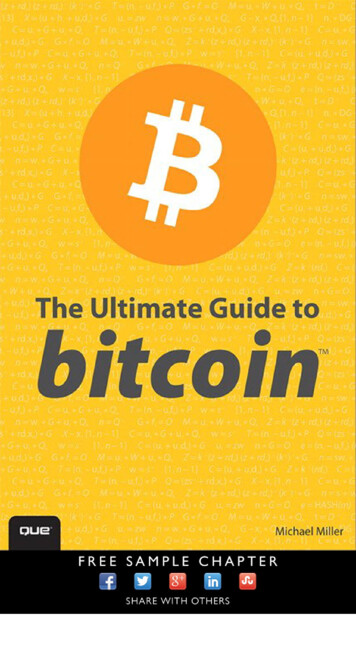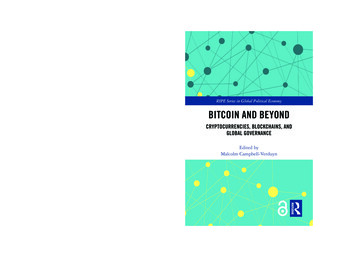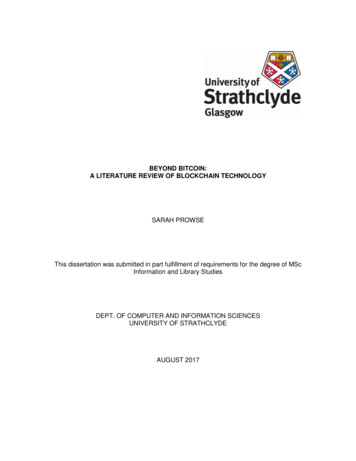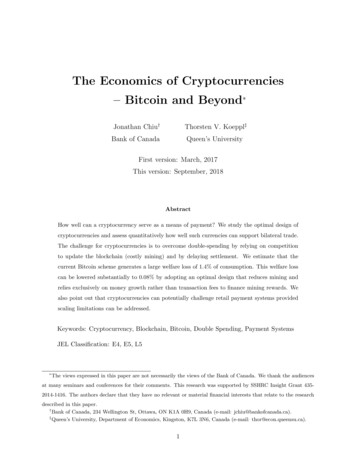
Transcription
The Economics of Cryptocurrencies– Bitcoin and Beyond Jonathan Chiu†Thorsten V. Koeppl‡Bank of CanadaQueen’s UniversityFirst version: March, 2017This version: September, 2018AbstractHow well can a cryptocurrency serve as a means of payment? We study the optimal design ofcryptocurrencies and assess quantitatively how well such currencies can support bilateral trade.The challenge for cryptocurrencies is to overcome double-spending by relying on competitionto update the blockchain (costly mining) and by delaying settlement. We estimate that thecurrent Bitcoin scheme generates a large welfare loss of 1.4% of consumption. This welfare losscan be lowered substantially to 0.08% by adopting an optimal design that reduces mining andrelies exclusively on money growth rather than transaction fees to finance mining rewards. Wealso point out that cryptocurrencies can potentially challenge retail payment systems providedscaling limitations can be addressed.Keywords: Cryptocurrency, Blockchain, Bitcoin, Double Spending, Payment SystemsJEL Classification: E4, E5, L5 The views expressed in this paper are not necessarily the views of the Bank of Canada. We thank the audiencesat many seminars and conferences for their comments. This research was supported by SSHRC Insight Grant 4352014-1416. The authors declare that they have no relevant or material financial interests that relate to the researchdescribed in this paper.†Bank of Canada, 234 Wellington St, Ottawa, ON K1A 0H9, Canada (e-mail: jchiu@bankofcanada.ca).‡Queen’s University, Department of Economics, Kingston, K7L 3N6, Canada (e-mail: thor@econ.queensu.ca).1
1IntroductionHow well can a cryptocurrency serve as a means of payment? Since the creation of Bitcoin in 2009,many critics have denounced cryptocurrencies as fraud or outright bubbles. More nuanced opinionshave argued that such currencies are only there to support payments for illegal activities or simplywaste resources. Advocates point out, however, that – based on cryptographic principles to ensuresecurity – these new currencies can support payments without the need to designate a third-partythat controls the currency or payment instrument possibly for its own profit.1We take up this discussion and develop a general equilibrium model of a cryptocurrency thatuses a blockchain as a record-keeping device for payments. Although Bitcoin in its current formhas immense welfare costs, an optimally designed cryptocurrency can potentially support paymentsrather well. First, using Bitcoin transactions data, we show that the welfare cost of a cryptocurrencycan be comparable to a cash system with moderate inflation. Second, using summary statistics forUS debit card transactions, we find that a cryptocurrency can perform nearly as well as a low-value,retail payment system operating with very low fees.2Economics research so far has provided little insight into the economic relevance of cryptocurrencies.Most existing models of cryptocurrencies are built by computer scientists who mainly focus on thefeasibility and security of these systems. Crucial issues such as the incentives of participants tocheat and the endogenous nature of some key variables such as the real value of a cryptocurrencyin exchange have been largely ignored. Such considerations, however, are pivotal for understandingthe optimal design and, hence, the economic value of cryptocurrency as a means of payment.Our focus is primarily on understanding how the design of a cryptocurrency influences the interactions among participants and their incentives to cheat. These incentives arise from a so-called“double-spending” problem. Cryptocurrencies are based on digitial records and, thus, can be copiedeasily and costlessly which means that they can potentially be used several times in transactions1Some central banks have recently started to also explore the adoption of cryptocurrency and blockchain technolo-gies for retail and large-value payments. Examples are the People’s Bank of China who aims to develop a nationwidedigital currency based on blockchain technology; the Bank of Canada and the Monetary Authority of Singapore whoare studying its usage for interbank payment systems; and the Deutsche Bundesbank who has developed a preliminaryprototype for blockchain-based settlement of financial assets.2This raises the issue that many cryptocurrencies currently cannot be scaled sufficiently to function as a truereplacement of large retail payment networks. We abstract completely from such scalability issues that mainly arisefrom technological constraints.2
(for a more detailed description see Section 2 below). We formalize this double-spending problemand show how this problem is being addressed by (i) a resource-intensive competition for updatingthe records of transaction – a process commonly referred to as mining – and (ii) by introducing confirmation lags for settling transactions in cryptocurrency. This implies that a cryptocurrency facesa trade-off between how fast transactions settle and a guarantee (or “finality”) for their settlement.Consequently, crytocurrencies cannot achieve immediate and final settlement of transactions.A strength of our analysis is that we take into account the costs of operating a cryptocurrencythat prohibits double-spending. This allows us to quantitatively assess how efficient Bitcoin as amedium of exchange can be relative to existing means of payment. Calibrating our model to Bitcoindata, we find that from a social welfare perspective using Bitcoin is close to 500 times more costlythan using traditional currency in a low inflation environment.This is, however, a result of the inefficient design of Bitcoin as a cryptocurrency. Bitcoin usesboth currency growth and transaction fees to generate rewards for mining. In its current form, thecryptocurrency reward structure is too generous so that too many resources are being used to ruleout double-spending and making it a secure form of payment. We show that the optimal way ofproviding rewards for mining is exclusively via currency creation at a very low rate rather than byusing transaction fees. The optimal design of Bitcoin would generate a welfare cost of only about0.08% of consumption which is equivalent to a cash system with moderate inflation.We also evaluate the efficiency of using a cryptocurrency system to support large-value and retailtransactions. Using summary data for Fedwire and US Debit cards, we confirm that cryptocurrencies are a much better alternative for low value, high-volume transactions than for large valuepayments. This is intuitive, as double spending incentives increase with the size of transactions.Hence, more mining and longer confirmation lags (which are both costly) are required when supporting large-value payments in a cryptocurrency. Our exercise shows that cryptocurrency systemscan potentially be a valid alternative to retail payment systems that operate at very low fees, assoon as limits on the scale of such systems can be resolved.The economic literature on cryptocurrencies is very thin. We are not aware of any work thathas formalized the design features of a cryptocurrency and that has studied its optimal designunder the threat of double spending attacks. We model bilateral exchange based on money, wefollow the recently promoted framework of Lagos and Wright (2005) and enrich it by modelling amining competition to update the blockchain. For formalizing the blockchain itself, we rely on the3
theoretical literature of payment systems as a record-keeping device.3Our work is thus a first attempt to explicitly model the distinctive technological features of acryptocurrency system which are a blockchain, mining and double-spending incentives within aquantitative economic model. We are also first to theoretically analyze the optimal design of acryptocurrency and giving a quantitative answer to the efficiency properties of cryptocurrencies.Some recent contribution have analyzed – from a qualitative perspective – whether Bitcoin canfunction as a real currency given its security features and lack of usage for making frequent payments(see for example Yermack (2013) and Böhme et al. (2015)). One question in this line of researchis to empirically explain the valuation of cryptocurrencies. Gandal and Halaburda (2014) look atnetwork effects associated with cryptocurrencies and investigate how such effects are reflected intheir relative valuation. Glaser et al. (2014) look at how media coverage of Bitcoin drives part ofthe volatility in its valuation.4Another area of research investigates how digital currencies can influence the way monetary policy isconducted. But none of this work can be applied to cryptocurrencies that are based on a blockchainand operate without a designated third-party to issue the currency. Agarwal and Kimball (2015)advocate here that the adoption of digital currencies can facilitate the implementation of a negativeinterest rate policy, while Rogoff (2016) suggests that phasing out paper currency can undercutundesirable tax evasion and criminal activities. Our findings complements this work as we establishsome potential bounds on the costs that can be levied on people through central bank issueddigital currency.5 Finally, Fernández-Villaverde and Sanches (2016) model cryptocurrencies asprivately issued fiat currencies and analyze – in the tradition of the literature on the free bankingera – whether competition among different currencies can achieve price stability and efficiency ofexchange.34See for example Koeppl et al. (2008) and (2012).Models have been developed for studying other forms of electronic money technologies. For example, Berentsen(1998) studies digital money such as smart cards; Gans and Halaburda (2013) study platform-specific digital currenciessuch as Facebook Credits; Chiu and Wong (2015) review e-money technologies including PayPal and Octopus Card.5See the recent discussion of Bordo and Levin (2017) on central bank issued digital currency. Also, Camera (2017)reviews the monetary literature and discusses the challenges of issuing and adopting electronic alternatives to cash.4
2Cryptocurrencies: A Brief IntroductionOur modern economy relies heavily on digital means of payments. Trade in the form of e-commercefor example necessitates the usage of digital tokens. In a digital currency system, the means ofpayment is simply a string of bits. This poses a problem, as these strings of bits as any otherdigital record can easily be copied and re-used for payment. Essentially, the digital token can becounterfeited by using it twice which is the so-called double-spending problem.Traditionally, this problem has been overcome by relying on a trusted third-party who managesfor a fee a centralized ledger and transfers balances by crediting and debiting buyers and sellers’accounts. This third-party is often the issuer of the digital currency itself, one prominent examplebeing PayPal, and the value of the currency derives from the fact that users trust the third-partyto prohibit double-spending (top of Figure 2.1).Cryptocurrencies such as Bitcoin go a step further and remove the need for a trusted third-party.Instead, they rely on a decentralized network of (possibly anonymous) validators to maintain andupdate copies of the ledger (bottom of Figure 2.1). This necessitates that consensus between thevalidators is maintained about the correct record of transactions so that the users can be sure toreceive and keep ownership of balances. But such a consensus ultimately requires that (i) users donot double-spend the currency and (ii) that users can trust the validators to accurately update theledger.How do cryptocurrencies such as Bitcoin tackle these challenges? Trust in the currency is basedon a blockchain which ensures the distributed verification, updating and storage of the record oftransaction histories.6 This is done by forming a blockchain. A block is a set of transactionsthat have been conducted between the users of the cryptocurrency. A chain is created from theseblocks containing the history of past transactions that allows one to create a ledger where onecan publicly verify the amount of balances or currency a user owns. Hence, a blockchain is like abook containing the ledger of all past transactions with a block being a new page recording all thecurrent transactions.Figure 2.2 illustrates how the blockchain is updated. To ensure consensus, validators compete for6In this sense it is different from traditional money which is merely a partial memory of past transactions as itonly records the current distribution of balances and does not record how past transactions generate the currentdistribution.5
Digital tokens with a trusted third party (e.g. PayPal)Digital tokens without a trusted third party (e.g. Bitcoin)Figure 2.1: Digital Currency vs. Cryptocurrency6
Figure 2.2: Blockchain Based Validation in a Cryptocurrencythe right to update the chain with a new block. This competition can take various forms. In Bitcoin,it happens through a process called mining. Miners (i.e. transaction validators) compete to solvea computationally costly problem which is called proof-of-work (PoW).7 The winner of this miningprocess has the right to update the chain with a new block. The consensus protocol prescribesthen that the “longest” history will be accepted as the trusted public record.8 Since transactionvalidation and mining are costly, a reward structure is needed for mining to take place. In Bitcoin,for example such rewards are currently financed by the creation of new coins and transaction fees.9The main concern for users when trusting a cryptocurrency is the double spending problem: afterhaving conducted a transaction, a user attempts to convince the validators (and, hence, the generalpublic if the blockchain is trusted) to accept an alternative history in which some payment wasnot conducted.10 If this attack succeeds, this user will keep both the balances and the product78Other consensus protocols are being explored which we briefly discuss in the Appendix.In general, there is no explicit requirement to follow the consensus protocol in the sense that validators and userscan trust an alternative history or blockchain that is not the longest one. Well-designed cryptocurrency, however,try to ensure that there are sufficient incentives to work with the longest history. For example, in Bitcoin the rewardpaid to a successful miner is contained in the new block itself. Should a different chain be adopted at a later stage,this reward will be obsolete. For a game-theoretic analysis of the incentives to build on the longest chain, see Biaiset. al. (2017).9Huberman et al. (2017) explore the reward structure of cryptocurrencies from the perspective of the mininggame, but without modelling the double spending problem.10While basic cryptography ensures that people cannot spend others’ balances, a miner can exclude from a block7
or service he obtained while the counterparty will be left empty handed. Hence, the possibility ofsuch double-spending can undermine the trust in the cryptocurrency.A blockchain based on a PoW consensus protocol naturally deals with changing transaction historybackwards. The blockchain has to be dynamically consistent in the sense that current transactionshave to be linked to transactions in all previous blocks.11 Consequently, if a person attempts torevoke a transaction in the past, he has to propose an alternative blockchain (with that particulartransaction removed) and perform the PoW for each of the newly proposed block. Therefore, it isvery costly to rewrite the history of transactions backwards if the part of the chain that needs tobe replaced is long. Hence, the “older” transactions are, the more users can trust them.Unfortunately, a blockchain does not automatically protect a cryptocurrency against a doublespending attack that is forward-looking. Figure 2.3 considers a spot trade between a buyer anda seller involving a cryptocurrency. The buyer instructs the miners to transfer a payment to theseller while the seller simultaneously delivers the goods. Notice that the buyer can always secretlymine an alternative history (or submit to some miners a different history) in which the fund isnot transferred. The final outcome of the transaction depends on which payment instruction isincorporated into the blockchain first. If the former payment instruction is incorporated, then thedouble-spending attempt fails. The seller receives the payment and the buyer gets the goods. Ifthe latter is accepted instead, then the double-spending attempt succeeds. In this case, the buyergets the goods without paying the seller.Such a double spending attack can be discouraged by introducing a confirmation lag into thetransactions. By waiting some blocks before completing the transaction (i.e., the seller delays thedelivery of the goods), it becomes harder to alter transactions in a sequence of new blocks. Figure2.4 illustrates how a confirmation lag of one block confirmation raises the secret mining burden ofa double spender. The seller delivers the goods only after the payment is incorporated into theblockchain at least in one new block. Again, the buyer can secretly mine an alternative historyin which the payment does not happen. How successful secret mining is depends on the miningcompetition and the length of the confirmation lag.some transactions that have been initiated by other people. With positive transaction fees, a miner does not have anincentive to remove other people’s transactions and lose such fees.11For example, if someone transfers a balance d in block T , it must be the case that the person has receivedsufficient net flows from block 0 to block T 1 so that the accumulated amount is at least d.8
Double spending attempt failsDouble spending attempt succeedsFigure 2.3: Double Spending Attack9
Suppose the buyer successfully solves the PoW for the block containing this alternative history.Note that the buyer has an option whether to broadcast the secretly mined block immediately orwithhold it for future mining. If he decides to broadcast the block immediately, the seller will notreceive the payment, but he will also not deliver the goods as shown on the top of the figure. Hence,the double-spending attack is not successful for the buyer.Alternatively, the buyer can temporarily withhold the solved block and continue to secretly mineanother block (depicted on the bottom of the figure). Specifically, the buyer needs to allow otherminers to confirm the original payment to the seller, so as to induce the seller to deliver the goods.At the same time, the buyer needs to secretly mine two blocks in a row for which the originaltransaction is removed.12 If the buyer is successful in mining two blocks faster than other miners,he can announce an alternative blockchain after the goods are delivered. In this case, the buyergets the goods without paying the seller. More generally, if the seller delivers the goods only afterobserving N confirmations of the payment, the buyer needs to solve blocks N 1 consecutive timesin order to double spend successfully.To summarize, trust in a cryptocurrency system involves the interplay of three ideas: the securityof the blockchain, the health of the mining ecosystem and the value of the currency.13 As shownin Figure 2.5, sufficient mining activities are required for ensuring the security of the blockchain,safeguarding it against attacks and dishonest behaviors. Moreover, only when users trust thesecurity of system will the cryptocurrency be widely accepted and and traded at a high value.Finally, the value of the currency supports the reward scheme to incentivize miners to engage incostly mining activities.Our model will capture precisely this interdependence by explicitly looking at the joint determination of mining efforts, rewards and cryptocurrency value in general equilibrium. The main featuresof a cryptocurrency model in Section 3 are therefore given by(i) a consensus protocol: miners compete to update a blockchain with the probability of winningbeing proportional to the fraction of computational power owned by a miner12Since the consensus protocol prescribes that the longest chain is accepted by the miners, the double spenderneeds to mine two blocks in order to create an alternative, longer blockchain superseding the existing one which hasone block solved already.13This has been pointed out already in the computer science literature (see for example Narayanan et al. (2016)),but without making the connection to an equilibrium incentive problem for double spending.10
Double spending attempt fails (with one confirmation lag)Double spending attempt succeeds (with one confirmation lag)Figure 2.4: Double Spending Attack when Confirmation Lag11
Security ofblockchainmake doublespending costlymerchants willing toaccept currencyMiningactivitiesValue ofcurrencyreward schemeFigure 2.5: Bootstrapping in a Cryptocurrency System(ii) settlement lags: double spending is discouraged by sellers waiting for N validations beforedelivering the goods so that the buyer needs to win the mining game N 1 times in order torevoke a payment(iii) a reward scheme: rewards for winning miners are financed by seigniorage (new coins) andtransaction fees.3The Double Spending ProblemAs pointed out in the previous section, due to its digital nature, a cryptocurrency system is subjectto the double spending problem. To focus on this problem, this section develops a partial equilibrium model to study the mining and double-spending decision within one payment cycle. Takingas given the price and quantity of balances, the terms of trade and the mining rewards, this basicmodel determines the mining activities and the buyers’ incentives to double spend. In the nextsection, we will incorporate this basic set-up into a general equilibrium monetary model to performa full analysis.12
3.1Basic Set-upWe begin our analysis by looking at a single transaction period. As shown in Figure 3.1, there areN̄ 1 subperiods within the single period. In subperiod 0, a buyer meets a seller to negotiate atrade. All other subperiods 1, . . . , N̄ serve as periods for confirming and settling trades that takeplace in subperiod 0.sellerdelivers xnegotiate (x, d, N )buyer sends dn 0n 1n 2.n Nbuyerdoublespends.n N̄Figure 3.1: Timeline for a single transaction periodThe buyer carries a real balance of cryptocurrency equal to z that can be used to buy an amount ofgoods x from a seller. Upon being matched, the buyer and the seller bargain to determine the termsof trade (x, d, N ) which specify that the buyer pays the seller d z units of real balances and thatthe seller commits to deliver x units of goods after a number of successive payment confirmationsN {0, . . . , N̄ } in the Blockchain.14 We call N the confirmation lag of the transaction. For now,the terms of trade are taken as given, but will be determined endogenously in the next section.The seller produces the good at unit costs, while the buyer’s preference for consuming an amountx with confirmation lag N are given byδ N u(x)(1)where δ (0, 1) is the discount factor between two subperiods. Hence, discounting across the wholetransaction period is given by15β δ N̄ 1 .(2)Finally, both buyers and sellers value real balances linearly and discount all payoffs that arise afterthe single transaction period at β.14We consider the case in which a seller can commit to deliver the good. If this were not the case, only spot tradescan be conducted that – as we show later – will always be subject to double spending.15There are two ways to interpret the discount factor δ: (i) buyers prefer earlier consumption or (ii) a buyer’spreference can change over time so that a seller’s goods will no longer generate utility with probability 1 δ.13
3.2MiningThere are also M miners who compete for updating a blockchain in subperiods n 0, ., N̄ with allthe transactions from subperiod 0. In each subperiod, miners perform exactly one costly computational task with a random success rate by investing computing power, q, measured in real balancesof cryptocurrency.16 This task is called the Proof-of-Work (PoW). We assume that miners valuereal balances linearly.As motivated by the Bitcoin protocol (see Property (i) in Section 2), if the computational powerof miner i in a subperiod is q(i), then the probability that a particular miner i will win the mininggame is given byq(i)ρ(i) PM.m 1 q(m)(3)In other words, the probability of wining is proportional to the fraction of computational powerowned. We take this feature as given here and provide a micro foundation for this result in theAppendix. By winning the competition in any subperiod, a miner can update the Blockchain (i.e.,append the nth block to the Blockchain) and receive a reward R in real balances. We assume thatminers receive and consume this reward after the period, discounted by the time preference β.Note that the mining games are independent across subperiods. Hence, in any subperiod miner isolvesmax ρi βR q(i)q(i)so thatPM q (i) 2 βR 1. (i)q(m) qi6 jm 1 q(m) P(4)(5)where he takes as given the choice by all miners m 6 i. Imposing symmetry, q(m) Q for all m,we obtain as the Nash equilibrium of the mining game thatQ M 1βR.M2(6)Consequently, the total computing cost of mining in any subperiod isMQ 16M 1βRM(7)One could assume that miners buy computing power q at price α so that z units of real balances yield computingpower q αz. We can, however, simply normalize α 1 by changing the unit for q.14
The expected profit of a miner in equilibrium across the single transaction period is thus given by#"N̄ 1QβR Q βR.(8)Πm (N̄ 1) PMM2m 1 QTo capture the fact that mining tends to be quite competitive and open to new entrants, we letM 17 to arrive at the following lemma.Lemma 1. As M , the expected value of miners is zero, and the aggregate computing powerof miners dissipates all rewards from miningM Q βR.3.3Secret MiningAs discussed in Section 2, an important concern in a cryptocurrency system is a buyer’s doublespending attempts (see Property (ii) in Section 2). When trading, the buyer needs to make apayment d to the seller. To do so, he has to send out an instruction to miners to update theBlockchain with the transaction. However, this is insufficient to ensure that the seller receives apayment. A buyer can engage in secret mining by attempting to mine a block in which his paymentdid not occur.18 A seller can protect himself from not receiving the payment by waiting to deliverthe goods until the payment has been incorporated into the blockchain.Such confirmation of the payment in the Blockchain however may still be not enough. A buyercan secretly mine a different Blockchain which could be released some periods after the seller hasdelivered the good replacing the original Blockchain.19 When such secret mining succeeds, the17The total number of miners is estimated to be within the range of 5000 to 100,000 (https://goo.gl/TPFBvA). Inaddition, according to blockchain.info, there are altogether 14 mining pools that individually can account for at least1% of the total hashrate. Finally, it is feasible for miners to use their existing mining capacities to mine differentcryptocurrencies. For example, ASICs (Application-specific integrated circuits) manufactured for Bitcoin can be usedto mine altcoins that use SHA-256 as the hashing algorithm (e.g., Namecoin and Peercoin).18The secret mining can be done either by the buyer himself or by hiring a miner to mine a block with the instructionthat the payment did not occur.19Notice that, with such secret mining, the buyer cannot spend the balances of any other agent because, to spendother agents’ balances, one would need to obtain the digital signature of other agents. He can only (i) change thepayment instructions of his own transaction and (ii) remove other payment instructions from being mined – and,hence, confirmed – in the block. Hence, in reality a buyer trying to double spend has to remove his own paymentand all other payment instructions involving his original balance being spent.15
buyer keeps his original balances and the goods while the seller will be left empty handed. Inresponse, the seller can choose to postpone the delivery of the goods and wait for N confirmations.This confirmation lag can potentially deter double spending by the buyer. The idea is that, to undoa transaction with a confirmation lag of N subperiods, a dishonest buyer needs to win the mininggame N 1 times in a row. As the number of lags increases, the total PoW required to revokea transfer is increasing, making it more costly for a buyer to double spend. Furthermore, secretmining is deterred by miners’ investments in computing power M Q which, according to Lemma1, is increasing in the reward R. We look next into the incentives to double spend and call anoffer (x, d, N ) double spending proof (DS-proof) if the buyer has no incentive to engage in doublespending in subperiod 0 after the acceptance of the offer.3.4Double Spending Proof ContractsConsider then a trade with the terms (x, d, N ). The buyer will receive the goods in subperiod Nwhen exactly N confirmations of the payment d have been observed in the Blockchain. To doublespend, a buyer can secretly mine an alternative history to undo his payment after he has receivedthe goods. This implies that the double spender needs to be the first one who solves the PoWproblem for N 1 consecutive subperiods; i.e., from subperiod 0 to subperiod N . For each of thefirst N subperiods, the buyer does not broadcast the new block immediately, so that some otherminers will update the Blockchain and confirm his payment to the seller. The buyer broadcasts hissecretly mined blockchain only after he receives the goods and solves the N 1th block. When thedo
cryptocurrency system which are a blockchain, mining and double-spending incentives within a quantitative economic model. We are also rst to theoretically analyze the optimal design of a cryptocurrency and giving a quantitati

